2 Likes
1 Comments
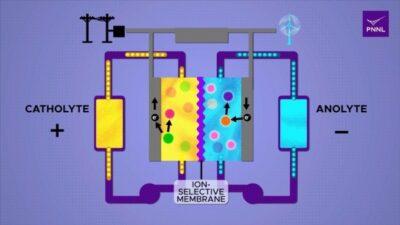
The discovery could lead to new low-cost, long duration energy storage systems that can write fossil energy out of the picture by capturing wind and solar power for weeks, months, or even whole seasons.
To provide full day, utility scale energy storage as more wind and solar power enter the grid, a flow battery fits the bill.
I really love that there is so much research, and the associated results flowing back, around all sorts of different approaches to batteries. Without a doubt, grid storage is now the big thing needed for variable power generation technology. Being storage, it can also be located where it is required for use.
See https://cleantechnica.com/2023/07/12/new-flow-battery-lasts-all-year-on-simple-sugar/
#Blog, #batteries, #environment, #gridstorage, #technology
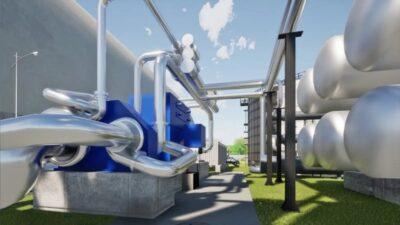
Long duration energy storage has yet to make a significant dent in the global energy profile. To date, the only widespread form of storage technology that can last longer than a few hours is the century-old “water battery,” in the form of hydropower reservoirs and their cousins, pumped hydro reservoirs.
On the plus side, hydropower dams and pumped storage systems already sport transmission infrastructure. Developers are eyeballing them for additional green power by adding floating solar arrays. However, hydropower facilities are site-specific, they disrupt habitats, and they are increasingly vulnerable to climate impacts.
BNEF Pioneers is in its 10th year of identifying “the most impactful and original technology innovations for advancing the low-carbon economy,” and Energy Dome is the first company to represent Italy in the competitive program. The winning technology is a closed-loop CO2 system that hits the magic 4-hour ceiling for short term energy storage, and then charges past it for up to 24 hours.
As for cost, that’s the sticky wicket — or not, as the case may be. Lithium-ion battery arrays are currently the system of choice for utility scale energy storage. The US Department of Energy’s National Renewable Energy Laboratory has been tracking a downward trend in the cost of Li-ion arrays, based on a typical duration of 4 hours. Energy Dome estimates it can beat Li-ion on costs by a mile, delivering up to 6 times that duration at half the cost.
See https://cleantechnica.com/2022/04/22/instant-long-duration-energy-storage-just-add-carbon-dioxide/
#environment #gridstorage #CO2 #storage
#Blog, ##co2, ##environment, ##gridstorage, ##storage

Long duration energy storage has yet to make a significant dent in the global energy profile. To date, the only widespread form of storage technology that can last longer than a few hours is the century-old “water battery,” in the form of hydropower reservoirs and their cousins, pumped hydro reservoirs.
On the plus side, hydropower dams and pumped storage systems already sport transmission infrastructure. Developers are eyeballing them for additional green power by adding floating solar arrays. However, hydropower facilities are site-specific, they disrupt habitats, and they are increasingly vulnerable to climate impacts.
BNEF Pioneers is in its 10th year of identifying “the most impactful and original technology innovations for advancing the low-carbon economy,” and Energy Dome is the first company to represent Italy in the competitive program. The winning technology is a closed-loop CO2 system that hits the magic 4-hour ceiling for short term energy storage, and then charges past it for up to 24 hours.
As for cost, that’s the sticky wicket — or not, as the case may be. Lithium-ion battery arrays are currently the system of choice for utility scale energy storage. The US Department of Energy’s National Renewable Energy Laboratory has been tracking a downward trend in the cost of Li-ion arrays, based on a typical duration of 4 hours. Energy Dome estimates it can beat Li-ion on costs by a mile, delivering up to 6 times that duration at half the cost.
See https://cleantechnica.com/2022/04/22/instant-long-duration-energy-storage-just-add-carbon-dioxide/
#environment #gridstorage #CO2 #storage
#Blog, ##co2, ##environment, ##gridstorage, ##storage
Ofgem is the independent energy regulator for the UK. Working with government, industry, and consumer groups, it strives to deliver a net-zero energy economy at the lowest cost to consumers while promoting competition and innovation. Recently, it has unveiled a proposed new policy that would expand the availability of vehicle-to-grid technology in the UK so that EV drivers can sell the energy stored in their car batteries back to power grid. It’s all part of a plan to make the switch away from fossil fuel cars more affordable for consumers.
In its purest form, V2G technology allows local utilities to draw power from the batteries of electric cars when demand peaks. That, in turn, allows them to avoid powering up so-called “peaker plants,” which are typically gas-fired thermal generating stations that sit idle until needed. Bringing them online is quite expensive. The dirty little secret of peaker plants is that they tend to emit large amounts of carbon dioxide during the start-up phase and are exempt from normal emissions rules during that time.
According to The Guardian, if enough drivers take advantage of the opportunity to make money from their car batteries by using vehicle-to-grid technology, the UK could avoid investing in new power plants with the equivalent generation capacity of up to 10 large nuclear power stations. That could help keep energy bills lower for all households in Great Britain, even those that do not have an electric vehicle parked in the driveway. An additional benefit is that tapping into a large number of vehicle batteries will allow utility companies to avoid some of the cost of installing grid scale battery storage facilities.
See UK Energy Regulator Supports Vehicle-To-Grid Proposal
#environment #EV #gridstorage #V2G #UK
The UK electricity regulator is proposing a new V2G initiative for the nation.
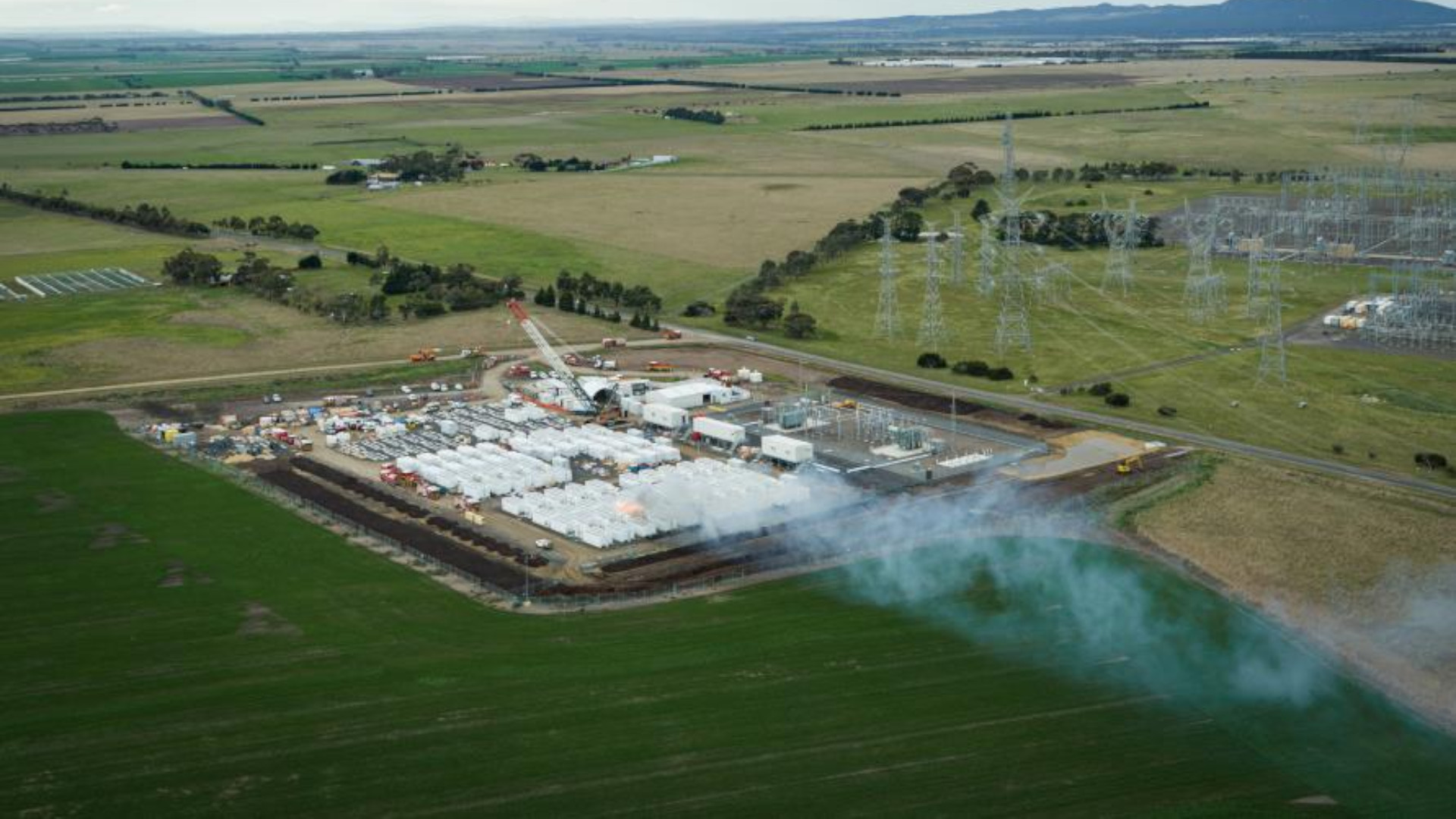
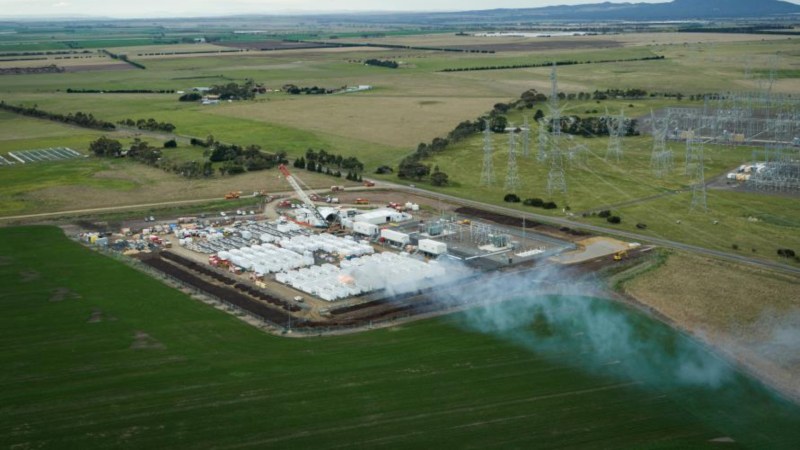
Lithium rechargeable batteries have been heralded for their high-density energy storage, enabling all manner of technologies to come to fruition. From drones to practical electric cars to large-scale grid storage, the applications are endless.
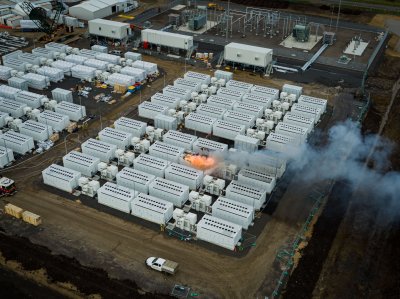 The fire as seen from a drone overhead. Source: Twitter/@FireRescueVic
The fire as seen from a drone overhead. Source: Twitter/@FireRescueVic
However, the lithium rechargeable battery has always had one major flaw-flammability. Pushed outside their operating range or otherwise tipped into thermal runaway, and they can burn ferociously as a result.
This came to pass in late July, at the Victorian Big Battery in Geelong, Australia, and it took significant effort to extinguish the blaze. Let's take a look at the project and see how this came to occur.
The Victorian Big Battery is a grid storage project similar in construction to the Hornsdale Power Reserve in neighboring South Australia. However, where the Hornsdale facility fields 194 MWh of capacity and 150MW peak power delivery, the new project aims to go much further. The Victorian project aims to install 450 MWh of capacity and deliver a peak power output of 300 MW.
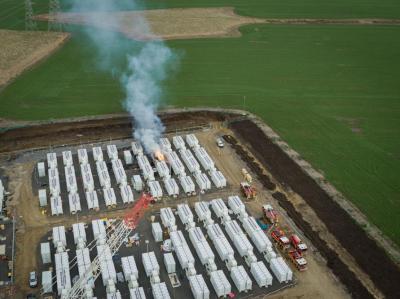 Concerns were raised about the smoke from the blaze, though local authorities gave downwind areas the all-clear soon after. Credit: CFA
Concerns were raised about the smoke from the blaze, though local authorities gave downwind areas the all-clear soon after. Credit: CFA
Operated by Neoen, the facility is built using Tesla Megapacks, large battery installations designed for grid storage purposes. Each Megapack contains batteries, inverters, and thermal management systems inside for a turnkey, plug-and-play solution to grid storage.
Initial testing of the battery was undertaken on July 30, with fire breaking out at approximately 10:15am according to official reports. The site was quickly disconnected from the grid with no interruption to the local electricity supply.
The fire burned for days, with firefighters announcing the blaze had been brought under control by 3PM on August 2. Lithium batteries tend to burn quite fiercely, and will often reignite after a time, so crews were left on site to monitor the battery for some time afterwards. Temperature readings were taken every two hours so that any heating or reignition could quickly be subdued.
The fire was fought by the members of the Country Fire Authority as well as Fire Rescue Victoria. CFA incident controller Ian Beswicke spoke on the blaze, noting the difficulty of tackling such fires. "They are difficult to fight because you can't put water on the Megapacks… all that does is extend the length of time that the fire burns for." Acting on advice from Tesla, Beswicke noted that "…the recommend process is you cool everything around it so the fire can't spread and you let it burn out."
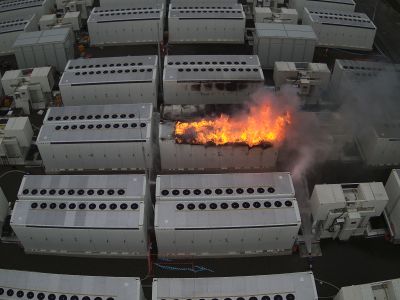 Visible are the individual Tesla Megapack units, each with its own thermal management system built-in. Credit: CFA
Visible are the individual Tesla Megapack units, each with its own thermal management system built-in. Credit: CFA
The fire began less than 24 hours after the battery began operating on the grid, according to sources quoted by the Sydney Morning Herald. Quick action by firefighting crews kept the entire facility from burning down, limiting the flames from spreading beyond a second battery pack.
Out of an abundance of concern for people in surrounding areas, a warning was given to those downwind of the incident. Two mobile units were deployed to the area by the Environment Protection Authority of Victoria. Despite early concerns and a warning for residents to shut windows and remain indoors, official reports soon gave the local atmosphere the all clear.
Obviously, a large fire lasting multiple days in a grid storage facility is an outcome that nobody wants. However, the events that followed serve as an indicator that authorities were well prepared to deal with the situation. No injuries were reported throughout the incident, and the fire was contained to a limited area of the facility. Only two battery packs caught fire out of the many on site (210 are planned in total), and electrical risks were properly managed to avoid disaster.
Questions remain as to how the fire started in the first place. Whether it comes down to an installation error or faulty equipment or batteries will likely be revealed by investigators in due time. For now, it's a black mark against Victoria's new battery project. However, in time, it may serve as an example of how through proper emergency management, lithium battery fires can be managed safely. The future of the electrical grid, and indeed, personal transport, may depend on it.
#currentevents #featured #news #battery #gridstorage #neoen #tesla